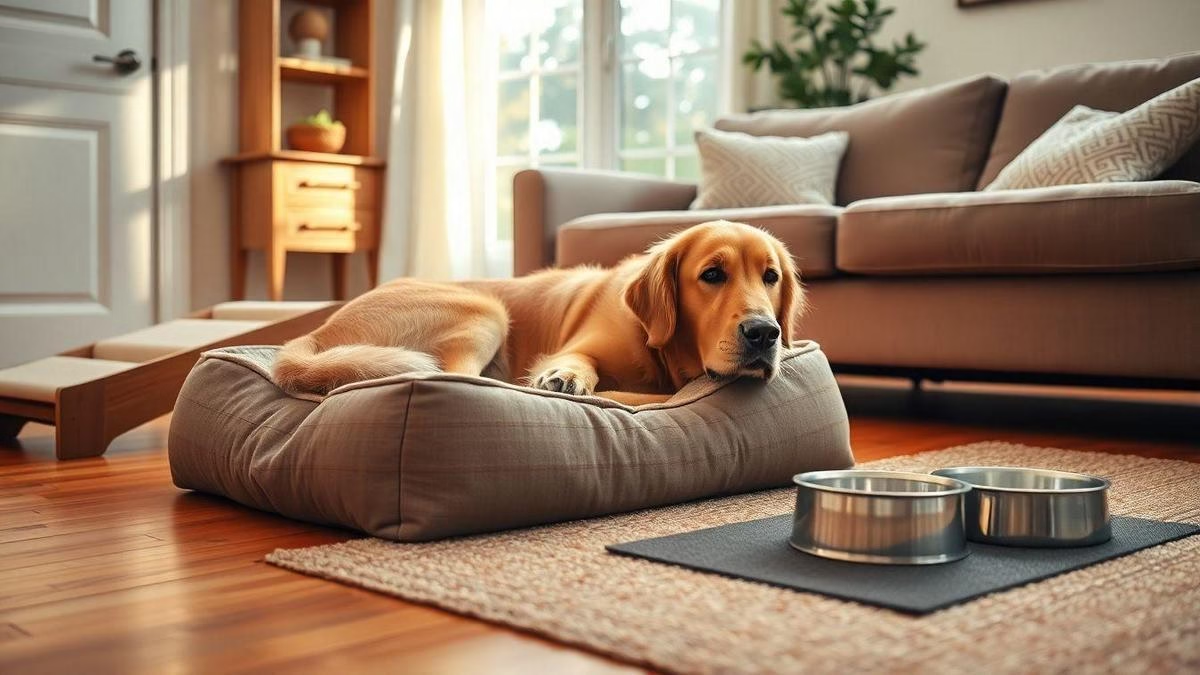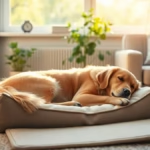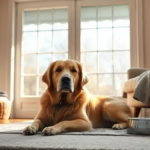Setting Up a Senior Golden Retriever-Friendly Home became my mission when my old buddy started auditioning for ice-skating on the hardwood. I planned room by room, mapped high-traffic zones and cozy rest spots, and fixed slippery floors with textured tiles, mats, rugs, and a quick wag-and-wobble traction test. I added ramps and stairs, picked indoor mobility aids and gently trained him with treats. I found an orthopedic bed with memory foam and low entry, set up raised bowls and non-slip water stations, and I work with our vet on meds, weight, gentle exercise, temp comfort, and dog-proofing to cut accident risks. This article walks you through my checklist, maps, and fixes so your golden can live comfy, safe, and tail-waggy.
Key Takeaway
- I add soft ramps so my golden avoids big jumps.
- I use non-slip rugs to stop my dog’s slip-and-slide.
- I give my dog a low, cozy bed for easy naps — chosen with tips from a guide on picking the right senior bed.
- I raise bowls so my dog eats without bending too much (mealtime setup).
- I keep night lights and clear paths to prevent midnight trips.
How I started my senior golden retriever home setup plan
I began with a single mission: keep my old Golden comfy and keep my floors intact. Marley started sleeping more and taking tiny naps mid-walk like a retiree who found a hammock. I watched him struggle over a single stair and thought, “Okay, we need a plan,” which in my house meant coffee, measuring tape, and a few panicked Googles.
Next, I picked small wins that made a big difference: a ramp for the couch, non-slip mats by the door, and a soft bed with bolsters. Each change cut down on those little sighs when Marley tried to get up. I tested one change at a time — new bed, new mat, new routine — and kept what worked. That slow tinkering saved money and sanity.
If you want a broader room-by-room checklist, see practical notes on how to adapt your home for a senior Golden.
I planned home modifications for senior dogs by room
I mapped each room like I was planning a tiny city for a very particular mayor.
Living room: lower furniture and a ramp;
Kitchen: clear paths and a soft rug;
Bedroom: an easy-access bed.
I used short trials — a rug for a week, a ramp for two — and watched if Marley used them without fuss. If he refused, I swapped colors or textures; sometimes a floppy mat was just the wrong kind of flop.
| Room | Key change | Why it helped |
|---|---|---|
| Living room | Ramp to couch, non-slip rug | Less jumping, safer play |
| Kitchen | Clear floor path, corner guards | Easier maneuvering, fewer scrapes |
| Bedroom | Low bed, night light | Easier access, fewer startled trips |
I kept choices practical and durable when possible. Fancy orthopedic foam is great, but not if Marley treats it like a chew toy. Small, visible improvements kept both of us motivated.
I used a checklist for Setting Up a Senior Golden Retriever-Friendly Home
I made a short, realistic checklist on my phone and stuck to it like peanut butter to a spoon. The list began with the basics: check gait, adjust steps, lighting, bedding, and vet-patient communication. I wrote items I could do in an afternoon and spaced bigger projects over weekends.
- Observe daily habits for a few days.
- Prioritize hazards (stairs, slippery floors).
- Add one mobility aid or bedding upgrade.
- Test for a week and note comfort changes.
- Call the vet about supplements or pain checks.
That checklist became my map when I felt lost. It turned a vague worry into small, doable fixes. For daily routines and simple care tips, I referred to simple daily care routines and built from there.
I mapped high-traffic zones and rest spots
I walked the house on Marley’s level, marking where he trotted, skidded, or plopped down. High-traffic zones got rugs and clear routes; rest spots got cozy beds and a low night light. Seeing the map helped me place ramps where they mattered and put water bowls where they’d actually be used. If you need ideas for mobility bottlenecks, the mobility solutions guide is handy.
How I fixed floors to stop my Golden from slipping
Bruno started doing his signature slide across the kitchen like he was auditioning for a canine ice dance. That wobble in his back legs and the little gasp after a near-fall hit me harder than I expected. Setting Up a Senior Golden Retriever-Friendly Home meant tackling the slippery floor problem before Bruno gave up on short walks or stopped chasing leaves in the yard.
I walked every room crouched awkwardly and bribed Bruno with treats, watching where he hesitated. Front door, tile kitchen, and the long hallway were the main danger zones. I replaced or treated the worst surfaces, added soft landing zones, and tested each change with Bruno before moving on.
I started small and cheap, then upgraded as I learned what worked. Within days of changing a few tiles and laying down runners, Bruno trotted with more confidence and fewer skid marks.
I chose non-slip flooring for golden retrievers like textured tiles and mats
Not every non-slip label means much to a dog who’s part otter. I picked textured porcelain in high-traffic spots, luxury vinyl plank with a good grip in the living room, and rubber matting in the mudroom. These options gave Bruno grip without turning the house into a bouncy castle. The textured tile cleaned easily after muddy paws, vinyl handled the living room zoomies, and rubber mats were perfect by the back door. For more product and layout ideas, see the roundup of essential equipment and supplies.
| Material | Pros | Cons |
|---|---|---|
| Textured Tile | Durable, easy to clean, good traction | Can be cold, needs grout care |
| Vinyl Plank | Warm underfoot, looks like wood, decent grip | Lower-grade vinyl may wear |
| Rubber Mats | Excellent traction, cushioned joints | Not always pretty, can trap dirt |
I also watched Bruno try different patches before committing. Small trials saved time and money. Ask for slip-resistance ratings at the store and pick low-profile textures so paws don’t get stuck between tiles.
I added area rugs and runners to cut fall risk
Rugs are like welcome mats with superhero capes for old dogs. I chose low-pile, washable runners with rubber backing and placed them where Bruno started his sprints. The goal was to reduce slip while keeping edges flat so Bruno wouldn’t trip. Rugs also absorb noise and give a warm spot for naps—double win. For tips on creating a calm, comfortable space with textiles and lighting, I looked at creating calm and peaceful environments.
- Measure the walkway, pick low-pile rug and non-slip pad, lay it flat, and anchor corners with tape or rug grippers.
I tested placements: a runner down the hallway, a small rug at the kitchen entrance, and a soft mat by the couch. Anchoring was key—corners that flipped up were more dangerous than bare floor. I wash the rugs regularly so Bruno still trusts them by smell.
I did a simple traction test with a wag and a wobble
My traction test was low-tech: I led Bruno across a sample patch, encouraged him with a treat, and watched for slips or hesitations. If his paws skidded more than a toe-width, I changed the surface. One confident tail wag meant I’d found a keeper.
How I added ramps and stairs to save his hips
When I started Setting Up a Senior Golden Retriever-Friendly Home, my old boy could still launch himself onto the couch like a furry cannon. That stunt stopped after his vet mentioned hips and slow wear-and-tear. I wanted solutions that looked decent in my living room and didn’t scream “dog rehab center.” I measured, watched him hop, and figured out where he really needed help: the bed, the couch, and the car.
I picked ramps and short stairs that matched his size and my furniture heights. A gentle slope matters more than a flashy brand — a long, gradual ramp is kinder to arthritic joints than a steep one. I also placed non-slip mats at the base and top. He inspected each new piece like a critic in a beret. Within days he used them regularly.
I installed ramps and stairs for older dogs to avoid jumping
I started with locations where he jumped the most: the couch and my bed. I measured heights and added ramps with a slope around 18–22 degrees, which kept the climb gentle. I secured ramps so they wouldn’t wobble; a steady ramp gets an anxious dog to commit. For step-by-step ideas on mobility solutions, the mobility issues guide was invaluable.
- Measure the height, choose a gentle slope, secure the ramp, and practice with treats.
I picked indoor mobility aids for elderly dogs that fit doorways and couches
Narrow doorways and low couches demanded collapsible ramps or modular stairs. I favored padded, non-slip surfaces and folding designs that slid behind a chair when not in use. The key was matching ramp length to drop — too short is too steep, too long clutters the room. For reliable product options, check the list of essential supplies.
| Ramp Type | Best For | Weight/Notes |
|---|---|---|
| Long foldable ramp | Car tailgate, high beds | Good for heavier dogs and gentler slope |
| Short modular stairs | Low couches, small steps | Easy to store, steady for small jumps |
| Soft foam ramp | Indoor quick hops | Lightweight, easy on paws but less durable |
I trained him gently to use each ramp with treats
I taught him in tiny steps: sniff the ramp, put one paw, then all four. Every successful attempt got a treat and a goofy cheer. Patience mattered more than speed; after a few rehearsals he moved confidently, and treats shifted from bribes to polite applause. For ideas on keeping training and enrichment low-impact and engaging, see mental activity and enrichment activities.
How I picked an orthopedic bed that he actually loves
I had a golden who treated every bed like a suggestion. When he got older, the suggestion turned into a grumpy refusal. I measured him when he stretched in his favorite sleeping pose, then added a few inches so he could sprawl. I paid attention to how he got in and out — slow and careful — which told me he needed support under his hips and chest, not a pillow that collapsed like a soufflé.
I tested beds by letting him choose. The real test was if he slept through thunder and the mailman. If he did, I knew I’d found a keeper.
I looked for orthopedic dog beds for seniors with memory foam support
Memory foam made a real difference. He used to shift every five minutes; with memory foam he settled like someone who’d finally found the right chair at the movies. Memory foam cradles pressure points — huge for hips and shoulders. For deeper guidance on picking the right mattress style for seniors, I followed a detailed piece on choosing the perfect bed and checked sleep habits against an ideal sleep routine.
Not all memory foam is equal. I picked a high-density option that keeps shape instead of flattening. My rule: thicker is better up to a point — about three inches of quality foam felt right.
- What I checked in the foam: density (higher is better), thickness (2–4 inches), cover breathability, and a firm base layer to stop sinking.
I chose low-entry beds and washable covers for easy care
Low-entry beds saved his dignity. He could step in without launching himself like a heroic film stunt. Washable covers were a sanity-saver. I picked a cover that zips off and survives the washing machine and used a waterproof liner under the foam.
I checked beds for sagging and replaced them when needed
I tested for sagging by pressing the center and watching recovery. If it stayed indented, I replaced it. A saggy bed is like a saggy couch: unusable and sad.
How I set up accessible feeding and water stations
Old Goldens do not have patience for awkward bowls. I spaced stations so he didn’t have to turn too far: one by his bed, one by the back door, and one in the kitchen. Routine helped: I topped water twice a day and checked food portions with a scoop. Quiet spots mattered — no clanging pans or vacuum ambushes near his bowl.
Small tweaks made a big difference. A low ramp to his favorite porch kept him from hauling himself down steep steps just to drink. I watched his posture and followed cues. Those tiny changes kept his tail wagging. For feeding strategies and appetite ideas, review mealtime tips and appetite stimulation.
I raised bowls to reduce neck strain for my big friend
I measured his elbow to the floor and used a stand at about that level. The goal was a natural head position — no awkward reaching. DIY stands worked fine; I used a sturdy wooden crate and sanded the top. Ceramic bowls stayed put and cleaned well.
- Measure elbow to floor, add 1–2 inches for comfort
- Choose a stable stand (wood or metal)
- Test with a towel — see if your dog holds a relaxed neck
- Swap bowls for shallow, wide options if needed
| Dog measure | Suggested stand height | Notes |
|---|---|---|
| Elbow to floor 10–12 in | 11–13 in | Small tweak for comfort |
| Elbow to floor 13–16 in | 14–17 in | Common for medium-large Goldens |
| Elbow to floor 17–20 in | 18–21 in | For taller seniors or deep chests |
I kept water fresh and put stations in quiet, easy spots
I changed water morning and evening and refilled as needed during hot days. A fountain helped because he liked the trickle sound. Location mattered — avoid busy doorways and noisy rooms. One station near his bed let him sip at night without getting up too much.
I used non-slip mats and measured food and water daily
Non-slip mats kept bowls from sliding under paws. I used rubber mats that folded easily for cleaning and measured food and water to keep weight steady. For building a healthy feeding routine, see maintaining a healthy routine.
How I manage arthritis and keep him safe and comfy
At about nine he developed that slow-mo trot. After a vet visit we called it arthritis and changed our life a little: rugs, low jumps, and an orthopedic bed. Small changes made his days brighter and his tail wag more often.
My daily routine now: short walks, gentle play, and extra nap breaks. I watch his energy, not the clock. If he limps or sits more, we cut the walk short and do nose-work games. I keep track with photos and notes and call the vet if stiffness lasts more than a few days.
| Item | Why it helps | How I use it |
|---|---|---|
| Orthopedic bed | Reduces pressure on joints | Placed near my chair so he can nap close to me |
| Non-slip mats | Prevents slipping on smooth floors | Laid at doorways and by the bed |
| Short walk nose games | Keeps him active without strain | Two 10-minute walks and 10 minutes sniff work daily |
I work with my vet on meds, weight control, and gentle exercise
I chat with the vet like we’re co-captains. We review pain meds, joint supplements, and side effects. I keep a simple chart of doses and behavior. For weight control, the vet set a target and a food plan. I measure meals, swap treats for veggies, and celebrate small wins with belly rubs. Exercise is gentle: pool time when possible, slow hill walks, and fetch with pauses. For arthritis-specific comfort and gentle exercise plans, see arthritis comfort, low-impact exercise ideas, and hydrotherapy precautions.
I set temperature control and senior dog comfort zones in hot and cold weather
Old Goldens are tiny thermostats with opinions. In summer, we create cool zones with shade, a fan, and a cool mat. I avoid midday walks and watch for heavy panting. In winter, cold stiffens bones, so I keep heating gentle, move his bed away from drafts, and use a soft blanket or light sweater for evenings. For overall comfort and calm, I referenced ideas on creating comfort and creating calm environments.
I dog-proofed loose cords, toxic plants, and stairs to cut accident risks
I hid cords behind furniture, removed dangerous plants, and added baby gates and ramps for stairs. Non-slip rugs and motion lights cut the chance of slips at night.
- Secure cords and tuck them away
- Remove toxic plants or put them out of reach
- Add non-slip surfaces and ramps for steps
For a quick equipment checklist to make your home safer, the essential supplies guide helped me lock down the obvious hazards.
Why Setting Up a Senior Golden Retriever-Friendly Home Matters
Setting Up a Senior Golden Retriever-Friendly Home isn’t just about gadgets — it’s about preserving mobility, dignity, and joy. Small, targeted changes reduce falls, ease joint pain, and keep your dog engaged. The payoff is huge: a calmer dog, fewer emergency vet runs, and more comfortable years together. For inspiration and stories of seniors thriving, read real senior golden stories.
Conclusion
I set out to stop the midnight ice-skating and ended up building a little kingdom of comfort and safety for my golden. Tiny, well-placed fixes — ramps, non-slip floors, an orthopedic bed, and raised bowls — add up to big wins. I tested, I watched, and I adjusted. Slow and steady, like teaching an old dog new tricks (and sometimes the human too).
Prioritize mobility, minimize slip risks, and keep a steady line of communication with the vet. Treats and patience help more than gadgets. Short trials save money and drama. Small comforts made him nap longer and wag harder.
If your pup needs a softer landing or your living room needs fewer dramatic exits, follow the checklist, watch the wag, and tweak until it fits. I promise — the payoff is a calmer dog and a happier you. For more practical, slightly quirky guides (and a few good dog stories), read more at https://topcuriosities.com.

Rafael Souza is a digital marketing strategist and lifelong dog enthusiast. Passionate about Golden Retrievers, he shares practical, research-based tips to help owners provide healthier and happier lives for their furry companions.





